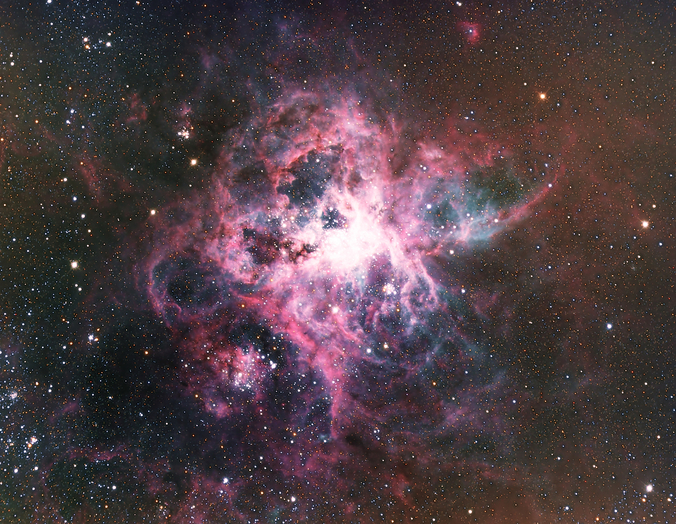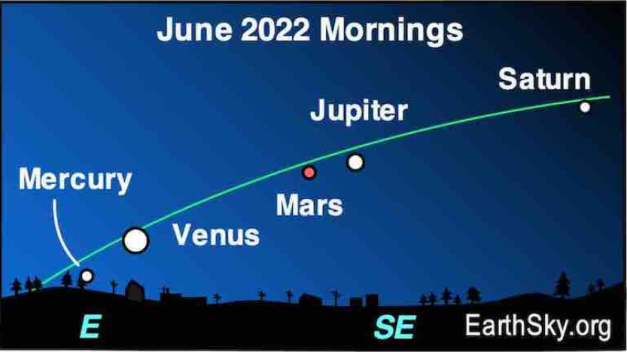Red Dirt Astronomy: Skies & Space for June 2022
May 31, 2022
Planets
Mercury – Emerging from the sun’s glow in the morning sky, the planet will finally become visible around the 10th. It will continue to rise higher each day, reaching is highest in the predawn sky on the 16th. Mercury will define the eastern end of the line of naked-eye planets along the ecliptic in June: Mercury, Venus, Mars, Jupiter and Saturn. On the mornings of the June 23-25, the waning crescent moon will join the parade in the gap between Mars and Venus. To complete the parade, Uranus and Neptune will also be present for telescopic view within the unusual lineup, all east of the Celestial Meridian before dawn!
Venus- Prominent in the morning sky lineup, Venus will be close of the waning moon on the 26th, in between the famous Pleiades and Hyades star clusters in Taurus.
Mars – Mars remains in Pisces as part of the month’s grand match of the planets in the morning sky. The crescent moon will be near the planet on the 22nd.
Jupiter – Near Mars during the first of the month, Jupiter will be close to the moon on the 21st.
Saturn- In Capricorn, the planet will enter its best telescopic viewing for 2022 between now and the August 14th opposition (closest point to Earth for the year).
Uranus- Uranus will be close to Venus on the 11th, but 10 magnitudes DIMMER!
Neptune- In Pisces this month and like all the other planets, will be part of the morning parade, only not visible to the unaided eye.

Sky & Space Anniversary Events for June 2022
June 5: STS 111 (Space Shuttle Endeavour) launched to the early space station, Destiny Laboratory Module (2002)
June 7: Extreme Ultraviolet Explorer launched (1992)
June 7: First quarter moon
June 11: Venus south of Uranus
June 12: Venera 4 (USSR) was launched to Venus & provided the first analysis of the Venusian atmosphere, primarily CO2 with traces of nitrogen and one percent oxygen (1967)
June 15: Mariner 5 launched to Venus for a flyby (1967)
June 16: Mercury at farthest point away from the sun, greatest elongation.
June 18: Saturn north of moon.
June21: Summer Solstice, summer begins
June 21: Uranus north of moon
June 26: Venus south of moon
June 27: STS-4 (Space Shuttle Columbia) launched on 7 day mission and landing at Edwards Air Force Base at mission end (1982)
June 27: Mercury south of moon
June 29: New moon
Object of the Month: Eta Carina Nebula (The Tarantula Nebula)
Located in the southern sky below the constellation Canis Major is the constellation Carina (ship’s keel), the home to one of the largest known nebulas in the Milkyway galaxy, the Tarantula. This is better known due to the famous Hubble image of the ‘Hormunculus’, also known as Eta Carina. 8,500 light years from Earth and 300 light years wide, the nebula is the home of this super luminous hypergiant star between 100 to 150 times the mass of the sun and four million times more luminous. The dark globules and some bright nebulosity point directly at the massive star. The nebula itself is a vast star forming region with many smaller star clusters and other interesting areas of nebulosity located within it.
Surrounding Eta Carina is the smaller feature called the Homumculus. This feature absorbs much of the light from Eta Carina itself and the result of a massive ejection of material in 1841 which briefly made Eta Carina the second brightest star in the sky.
This image is a composite of seven and a half hours of red, green and blue images from a very dark sky. Processing the final image was also lengthy, about three hours.


